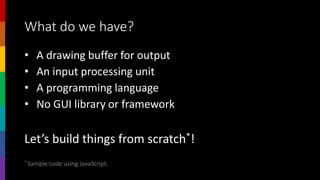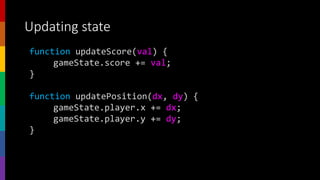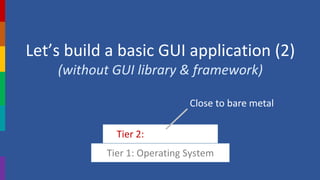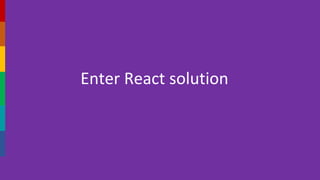Ad
The fundamental problems of GUI applications and why people choose React
- 1. TechTalk The fundamental problems of GUI applications & why people choose React Vu Nguyen [email protected]
- 2. TL;DR • All applications for normal users are GUI applications. • The fundamental problem is rendering GUI (include assembling GUI, handling user input and integrating with application logic). • This is not another talk about React, ES2015, Webpack, and other fancy things!
- 3. Desktop applications are GUI applications
- 4. Desktop applications are GUI applications Mobile applications are GUI applications
- 5. Desktop applications are GUI applications Mobile applications are GUI applications Web applications are GUI applications
- 6. Every application you use daily is GUI applications
- 7. Every application you use daily is GUI applications (We developers* are the only ones that work with terminal**) * Including programmers, hackers, specialists, etc. ** Even the terminal itself is a GUI application!
- 8. So if you want to build an application for normal users, you have no choice but GUI application!
- 9. Let’s build a basic GUI application (1) (without GUI library & framework) Tier 1: Operating System Bare metal
- 10. What do we have? • A drawing buffer for output • An input processing unit • A programming language • No GUI library or framework Let’s build things from scratch*! * Sample code using JavaScript.
- 11. 1235
- 12. The game loop Process input Update state Render while (playing) { processInput(); updateState(); render(); waitForNextFrame(); }
- 13. The game state var gameState = { score: 1235, time: 1200, player: { x: 120, y: 30, }, enemies: [ … ], bullets: [ … ] }; 1235
- 14. The rendering function function render() { renderBackground(); renderEnemies(); renderCharacter(); renderBullets(); renderScore(); renderTimeBar(); swapBuffer(); } 1235
- 15. Updating state function updateScore(val) { gameState.score += val; } function updatePosition(dx, dy) { gameState.player.x += dx; gameState.player.y += dy; }
- 16. Life of a GUI application state 1 1235 render()
- 17. Life of a GUI application state 1 1235 1235 state 2 render() render() updateState()
- 18. Life of a GUI application state 1 1235 1235 state 2 render() render() processInput() updateState() processInput()
- 19. Life of a GUI application state 1 1235 1235 state 2 render() render() processInput() updateState() processInput()
- 20. Luckily you don’t have to write “the loop” yourself. The operating system handles it for you.
- 21. The fundamental problems of GUI applications
- 22. The problems • Creating and assembling GUI • Handling user input • Integrating GUI & business logic
- 23. Basic GUI application architecture Viewstate render() input input logic
- 24. Assembling GUI Viewstate render() input input logic Viewstate render() input input logic Viewstate render() input input logic
- 25. Assembling GUI Viewstate render() input input logic Viewstate render() input input logic Viewstate render() input input logic input render()
- 26. Tier 1 • Creating and assembling GUI → render() function • Handling user input → (…) • Integrating GUI & business logic → do it yourself
- 27. What does a modern operating system offers? Tier 1: Operating System Bare metal
- 28. Process input Update state Render onClick() onKeydown() WM_LBUTTONDOWN WM_KEYDOWN onPaint() WM_PAINT Application business logic Application input logic Application rendering logic Operating System ApplicationEvent system
- 29. What does a modern operating system offers? • Handle “the loop” • Process raw input and provide event system
- 30. What does a modern operating system offers? • Creating and assembling GUI → (defer to app platform) • Handling user input → Event system • Integrating GUI & business logic → do it yourself
- 31. Let’s build a basic GUI application (2) (without GUI library & framework) Tier 1: Operating System Tier 2: App Platform Close to bare metal
- 32. What do we have? (at tier 2) • Component system • Event system Sample code using Windows API* * Win32 & COM API. Read more: https://msdn.microsoft.com/en-us/library/windows/desktop/ff381399(v=vs.85).aspx
- 33. The application state struct { int score, int time, PLAYER player, ENEMIES enemies, BULLETS bullets } gameState; 1235
- 34. The rendering function LRESULT CALLBACK WndProc(HWND hWnd, UINT message, WPARAM wParam, LPARAM lParam) PAINT_STRUCT ps; HDC hdc; switch (message) { case WM_PAINT: hdc = BeginPaint(hWnd, &ps); // ... EndPaint(hWnd, &ps); break; } }; 1235
- 35. Composing components • Create child windows • Attach them to the app window • In response to WM_PAINT: • Pass WM_PAINT to child windows
- 36. Handling input • Handling user input Response to input events WM_LBUTTONDOWN, WM_KEYDOWN • Handling application life cycle WM_CREATE, WM_DESTROY
- 37. Process input Update state Render onClick() onKeydown() WM_LBUTTONDOWN WM_KEYDOWN onPaint() WM_PAINT Application business logic Application input logic Application rendering logic Operating System ApplicationEvent system
- 38. What does a modern application platform offers? Tier 1: Operating System Tier 2: App Platform Close to bare metal
- 39. Android Platform • Composing elements: XML Layout, GUI components • Handling user input: Event system • Integrating business logic: Callback <Button xmlns:android="http://schemas..." android:id="@+id/button_send" android:text="@string/button_send" android:onClick="sendMessage" /> public void sendMessage(View view) { // Do something } http://developer.android.com/guide/topics/ui/controls/button.html
- 40. Windows Presentation Foundation (WPF) • Composing elements: XAML, GUI components • Handling user input: Event system • Integrating business logic: Handler <Button Grid.Column="1" Grid.Row="3" Margin="0,10,0,0" Width="125" Height="25" HorizontalAlignment="Right" Click="Button_Click">View</Button> private void Button_Click( object sender, RoutedEventArgs e) { // Do something } https://msdn.microsoft.com/en-us/library/mt270964.aspx
- 41. Web Platform (HTML & JS) • Composing elements: HTML, GUI components • Handling user input: Event system • Integrating business logic: Callback <button style="width:100px;height:40px" onclick="sayHello()"> Say Hello </button> function sayHello(e) { // Do something }
- 42. What does an application platform offers? • Creating and assembling GUI → Pre-built components, Domain specific language (DSL) for GUI • Handling user input → Event system • Integrating GUI & business logic → Callback, set state
- 43. Let’s build a basic GUI application (3) (without GUI library & framework) Tier 1: Operating System Tier 2: App Platform Tier 3: App
- 44. What do we have? (at tier 3, HTML & JS) • DSL & pre-built GUI components • Event system • Callback & set component state • No GUI library or framework. We still want to create our custom components! Let’s build a TODO application.
- 45. The application state var appState = { todos: [{ title: “hello”, complete: false }, { title: “world”, complete: false }] };
- 46. Updating state function addTodo(label) { appState.todos.push({ title: label, completed: false }); } function toggle(index) { var item = appState.todos[index]; item.completed = !item.completed; }
- 47. The rendering function function render() { // !? }
- 48. The rendering function – First try function render() { var $listTodos = document.getElementById(“todos”) for (var i=0; i < appState.todos; i++) { // update, insert or delete DOM elements } var $numActive = document.getElementById(“num-active”) $numActive.innerHTML = getNumActive(); // ... }
- 49. So far, we have defined application state and logic just fine. The only hard part that kept us back is rendering step. (Include generating HTML, keeping updated with app state and registering event callbacks)
- 50. The rendering function – Second try var lastState; // store last appState for comparing function render() { var $listTodos = document.getElementById(“todos”) for (var i=0; i < appState.todos; i++) { // update, insert or delete DOM elements } var $numActive = document.getElementById(“num-active”) $numActive.innerHTML = getNumActive(); // ... lastState = deepClone(appState); }
- 51. We have tried storing last application state for rendering only changed parts. This is what frameworks like Angular.js or Backbone (Underscore) offers.
- 52. Enter MVC & MVP
- 53. MVC • Applying Separation of Concern to GUI applications. • Input event → Controller → Model → View
- 54. MVP • Applying Separation of Concern to GUI applications. • Model → Presenter → View • View → Presenter → Model
- 55. Backbone.js var Todo = Backbone.Model.extend({ default: { title: "", complete: false }, toggle: function() { this.save(…); // trigger "change" (model) } }); var TodoView = Backbone.View.extend({ template: …, events: …, // callback to manipulate model (handled by controller) initialize: { this.listenTo(this.model, "change", this.render); // listen to "change" }, render: function() { … }, // rendering function (view) // … });
- 56. Angular.js (version 1) function TodoCtrl($scope) { var todos = $scope.todos = []; $scope.addTodo = function() { // user event todos.push({ title: $scope.newTodo, completed: false }); // update state }; $scope.$watchCollection("todos", function() { // state-change event // … }); } <form id="todo-form" ng-submit="addTodo()"> … </form> <ul id="todo-list"> <li ng-repeat="todo in todos"> … </li> </ul>
- 57. What does a application MV* framework offers? Tier 1: Operating System Tier 2: App Platform Tier 3: App
- 58. What does a MV* framework offers? • Creating and assembling GUI → view, template • Handling user input → user event • Integrating GUI & business logic → state-change event (Backbone.js, Angular.js)
- 59. Wow, so many concepts! model, view, template, controller, presenter, user event, state-change event Let’s return to our starting architecture
- 60. Life of a GUI application state 1 1235 1235 state 2 render() render() processInput() updateState() processInput()
- 62. Let’s put aside the fancy ways to define application state. The only hard part is rendering step.
- 63. The application state var appState = { todos: [{ title: “hello”, complete: false }, { title: “world”, complete: false }] };
- 64. Updating state function addTodo(label) { appState.todos.push({ title: label, completed: false }); } function toggle(index) { var item = appState.todos[index]; item.completed = !item.completed; }
- 65. The rendering function React.createClass({ render: function() { return ( <ul> { appState.todos.map(function(item) { return <li> { item.title } </li>; }) } </ul> ); } });
- 66. Handle state change React.createClass({ addTodoHandler: function() { var label = this.refs.inputTodo.value; addTodo(label); // update application state this.forceUpdate(); // trigger rendering function }, render: function() { return ( <div> <input ref="inputTodo"/> <button onClick={this.addTodoHandler}/> <ul> … </ul> </div> );} });
- 67. Life of a GUI application state 1 1235 1235 state 2 render() render() addTodoHandler() addTodo() toggleHandler() toggle()
- 68. React lets us work with our classic architecture and helps solving the hard part: rendering! No need to rewrite our application in an opinion way.
- 69. We only need to understand 2 functions to start working with React: - forceUpdate() - render()
- 70. What does React offers? • Creating and assembling GUI → React components • Handling user input → user events • Integrating GUI & business logic → keep GUI updated when application state changed
- 71. Why do people choose React?
- 72. What do people choose React? • As we see, the only hard part is rendering step. • React is a view library. It solves the right problem and solves it well. • It leaves application state for us. This is good because: • We work with classic architecture of GUI applications. • We can choose which architecture works best for us. • We can migrate legacy applications to React without changing so much code.
- 73. How to choose a library or framework? 1. Write the prototype by your own without using library or framework. 2. Understand what them offer. 3. Choose only which ones you need. 4. Keep in mind the design that you can switch to another library later.
- 74. What’s next? • Redux, an application state solution for React. • Because we understand how to handle application state, we can decide to use Redux or not. It’s up to you.
- 76. TechTalk The fundamental problems of GUI applications & why people choose React Vu Nguyen [email protected]













![The game state
var gameState = {
score: 1235,
time: 1200,
player: {
x: 120,
y: 30,
},
enemies: [ … ],
bullets: [ … ]
};
1235](https://image.slidesharecdn.com/techtalk-160319081000/85/The-fundamental-problems-of-GUI-applications-and-why-people-choose-React-13-320.jpg)































![The application state
var appState = {
todos: [{
title: “hello”,
complete: false
}, {
title: “world”,
complete: false
}]
};](https://image.slidesharecdn.com/techtalk-160319081000/85/The-fundamental-problems-of-GUI-applications-and-why-people-choose-React-45-320.jpg)
![Updating state
function addTodo(label) {
appState.todos.push({
title: label,
completed: false
});
}
function toggle(index) {
var item = appState.todos[index];
item.completed = !item.completed;
}](https://image.slidesharecdn.com/techtalk-160319081000/85/The-fundamental-problems-of-GUI-applications-and-why-people-choose-React-46-320.jpg)









![Angular.js (version 1)
function TodoCtrl($scope) {
var todos = $scope.todos = [];
$scope.addTodo = function() { // user event
todos.push({ title: $scope.newTodo, completed: false }); // update state
};
$scope.$watchCollection("todos", function() { // state-change event
// …
});
}
<form id="todo-form" ng-submit="addTodo()"> … </form>
<ul id="todo-list">
<li ng-repeat="todo in todos"> … </li>
</ul>](https://image.slidesharecdn.com/techtalk-160319081000/85/The-fundamental-problems-of-GUI-applications-and-why-people-choose-React-56-320.jpg)






![The application state
var appState = {
todos: [{
title: “hello”,
complete: false
}, {
title: “world”,
complete: false
}]
};](https://image.slidesharecdn.com/techtalk-160319081000/85/The-fundamental-problems-of-GUI-applications-and-why-people-choose-React-63-320.jpg)
![Updating state
function addTodo(label) {
appState.todos.push({
title: label,
completed: false
});
}
function toggle(index) {
var item = appState.todos[index];
item.completed = !item.completed;
}](https://image.slidesharecdn.com/techtalk-160319081000/85/The-fundamental-problems-of-GUI-applications-and-why-people-choose-React-64-320.jpg)










































































































